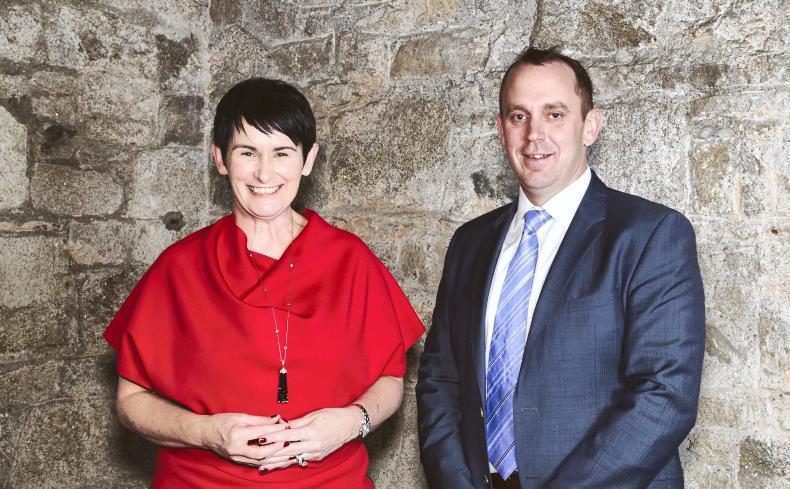The national telecommunications operator eir will complete the connection of 335,000 rural customers to fiber optics in June, the company's chief executive Carolan Lennon announced this Monday.
This is more than the 300,000 originally planned, with 35,000 additional premises identified for connection during the process.
The addresses to be connected by June are those marked in blue on the Department of Communication's broadband roll-out map.
Lennon said this was delivered within the €250m budget allocated from the company's own funds, without state support, and six months behind schedule.
We are a bit delayed, but we had Emma and Ophelia
"We are a bit delayed, but we had Emma and Ophelia," she said in reference to storms that hit the network in the past two years.
Lennon said that the company had decided to re-allocate resources to upgrade its network in cities and towns after June, connecting 1.4m homes and businesses directly to fiber optics. These addresses are currently connected through fibre for part of the way, but eir still uses old copper wires to reach their doorstep. Their connection speeds will increase from between 10Mb/s and 100Mb/s currently to 1Gb/s after the upgrade, which will will offer the capacity to boost this again to 10Gb/s in the future, Una Stafford, managing director of eir's fixed network, told the Irish Farmers Journal.
While this is good news for customers in the 180 towns with more than 1,000 premises, it will not improve connectivity for farmers and rural dwellers away from the main towns and roads (the areas marked in amber on the Department's map).The Government is due to choose a contractor this year to deploy broadband to these areas.
Complexity
"I think the National Broadband Plan will take five to seven years," Lennon said. She said that eir pulled out of the tender process for this job because its complexity would add too much cost – yet the winning bidder will have to work with eir to share infrastructure. A consortium led by US-based businessman David McCourt is the only remaining bidder in the process.
The contractor ultimately chosen by the Government will have to share infrastructure such as ducts and poles with eir. "The bidder has been engaging with us" recently after a lull, said Lennon. There have been calls for legislation to cap the price of accessing eir's infrastructure under the NBP, but "we haven't got sight of it," Lennon added.
Separately, eir confirmed a mobile upgrade plan announced in November aiming to cover 99% of the population with 4G within two years.
Read more
Rural broadband scheme not compromised – report
Minister for Communications Denis Naughten resigns
The national telecommunications operator eir will complete the connection of 335,000 rural customers to fiber optics in June, the company's chief executive Carolan Lennon announced this Monday.
This is more than the 300,000 originally planned, with 35,000 additional premises identified for connection during the process.
The addresses to be connected by June are those marked in blue on the Department of Communication's broadband roll-out map.
Lennon said this was delivered within the €250m budget allocated from the company's own funds, without state support, and six months behind schedule.
We are a bit delayed, but we had Emma and Ophelia
"We are a bit delayed, but we had Emma and Ophelia," she said in reference to storms that hit the network in the past two years.
Lennon said that the company had decided to re-allocate resources to upgrade its network in cities and towns after June, connecting 1.4m homes and businesses directly to fiber optics. These addresses are currently connected through fibre for part of the way, but eir still uses old copper wires to reach their doorstep. Their connection speeds will increase from between 10Mb/s and 100Mb/s currently to 1Gb/s after the upgrade, which will will offer the capacity to boost this again to 10Gb/s in the future, Una Stafford, managing director of eir's fixed network, told the Irish Farmers Journal.
While this is good news for customers in the 180 towns with more than 1,000 premises, it will not improve connectivity for farmers and rural dwellers away from the main towns and roads (the areas marked in amber on the Department's map).The Government is due to choose a contractor this year to deploy broadband to these areas.
Complexity
"I think the National Broadband Plan will take five to seven years," Lennon said. She said that eir pulled out of the tender process for this job because its complexity would add too much cost – yet the winning bidder will have to work with eir to share infrastructure. A consortium led by US-based businessman David McCourt is the only remaining bidder in the process.
The contractor ultimately chosen by the Government will have to share infrastructure such as ducts and poles with eir. "The bidder has been engaging with us" recently after a lull, said Lennon. There have been calls for legislation to cap the price of accessing eir's infrastructure under the NBP, but "we haven't got sight of it," Lennon added.
Separately, eir confirmed a mobile upgrade plan announced in November aiming to cover 99% of the population with 4G within two years.
Read more
Rural broadband scheme not compromised – report
Minister for Communications Denis Naughten resigns






 This is a subscriber-only article
This is a subscriber-only article










SHARING OPTIONS: